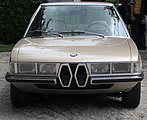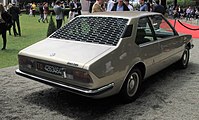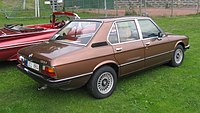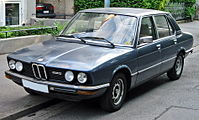BMW E12
| BMW | |
|---|---|
|
BMW 5 Series (1972-1976)
|
|
| E12 | |
| Sales designation: | 5 series |
| Production period: | 08 / 1972-06 / 1981 |
| Class : | upper middle class |
| Body versions : | limousine |
| Engines: |
Petrol engines : 1.8-3.5 liters (66-160 kW) |
| Length: | 4620 mm |
| Width: | 1690 mm |
| Height: | 1425 mm |
| Wheelbase : | 2636 mm |
| Empty weight : | 1240-1530 kg |
| Previous model | BMW New Class |
| successor | BMW E28 |
The BMW with the factory code designation E12 is the first BMW of the 5 series , the successor to the " New Class ", and was produced from the summer of 1972 to mid-1981.
With him, BMW initiated a reorganization of the model naming. The first 5 series was only offered as a four-door notchback sedan.
BMW essentially took over the platform from the new class: front engine and rear-wheel drive, individually suspended wheels - front wheels on MacPherson struts and wishbones , the rear on slightly adjusted swing arms (" trailing arm axle ") - rack and pinion steering and hydraulically operated brakes ( disc brakes on the front axle , rear drum brakes )
Model history
General
From 1968 BMW planned the successor for the new class (1800 and 2000). The name "520" came up relatively early to build a bridge to the BMW 501 and 502 models . In March 1970, a study designed by Marcello Gandini for Bertone was presented as the “BMW 2200TI” (Garmisch). Their rectangular headlights, however, would not have suited a BMW. In 1971 this was corrected.
In 1970 BMW hired Paul Bracq as a designer, the E12 was his first creation for BMW. The drag coefficient of the body of the E12 is c w = 0.44.
In September 1972, BMW introduced what is now known as the 5 Series. The E12 was the first BMW to have the series designation (in this case a five) in front. In mid-1975 it was followed by the E21 (first 3 series) and in early 1976 by the E24 (first 6 series) of this type.
The E12 engine program, which was expanded during the construction period, ranged from the small 1.8 liter displacement in the 518, whose engine was already known from the BMW 1800, to the 3.5 liter displacement in the M535i, which was built in small numbers towards the end of the series. The BMW 518 and BMW 520 / 520i have the four-cylinder M10 engines . From the summer of 1977 the BMW 520 was equipped with the newly developed small six-cylinder M20 engine. The larger-displacement variants of the 5-series BMW were equipped with the large M30 six-cylinder engine. It all started with the 525 with a displacement of around 2.5 liters at the 1973 IAA.
Externally, the 525 and 528 were identified by the raised area in the middle of the bonnet - this area was slightly recessed on the four-cylinder engines - and a lettering on the radiator grille.
There was no diesel engine in the BMW E12 because the company did not yet have diesel engines in its range. The comparatively clumsy diesel engines of the 1970s, mostly without a turbocharger, did not fit into the BMW concept. Only in the successor model E28 was a diesel engine ( M21 ) offered, which was derived from the M20 engine.
Facelift
The E12 facelift came in August 1976: the most eye-catching feature was the bonnet slightly curved around the BMW “kidneys”, which was now the same for all engine versions. The versions with the M30 engine were given a chrome surround on the radiator grille.
The rear lights became larger, and the tank filler neck was relocated from the rear (right next to the license plate) to the right rear fender to increase crash safety. The tank capacity for the four-cylinder was now 70 l (previously 56 l).
In the interior, the vertical air outlets were now adjustable; the steering wheel was encased in soft plastic and its shape corresponded to that of the 6 and 7 models . The engines of the models 525 and 528 were revised, they got a double register carburetor of the type Solex 4A1 instead of the Zenith carburetor ; The output increased from 107 to 110 kW for the 525, and for the 528 from 121 to 125 kW.
In June 1981 the production of the E12 in Germany ended. A total of 722,435 copies of the first 5 series were made.
After production in Germany was discontinued, BMW South Africa took over the pressing tools from Germany and from then on manufactured the E12 with the interior fittings of the successor E28 until 1985. There there was the 520 with a two-liter four-cylinder (85 kW / 115 hp) and the 528 with a carburettor engine (125 kW / 170 PS, standard ZF three-speed automatic) and the 530 (130 kW / 177 PS with four-speed transmission).
The BMW E28 then also replaced the BMW E12 in South Africa and was produced there until 1989.
Engines
Petrol engines
| model | engine | Displacement | cylinder | Power at 1 / min | Torque at 1 / min | V max | construction time |
|---|---|---|---|---|---|---|---|
| 518 | BMW M10 | 1766 cc | 4th | 66 kW (90 PS) at 5500 | 145 Nm at 3500 | 160 km / h | 05/1974 to 02/1975 |
| 518 | 1766 cc | 4th | 66 kW (90 PS) at 5800 | 143 Nm at 3700 | 160 km / h | 02/1975 to 08/1976 | |
| 518 | 1766 cc | 4th | 66 kW (90 PS) at 5800 | 143 Nm at 3700 | 160 km / h | 04/1976 to 01/1978 | |
| 518 | 1766 cc | 4th | 66 kW (90 PS) at 5800 | 140 Nm at 3700 | 160 km / h | 01/1978 to 02/1980 | |
| 518 | 1766 cc | 4th | 66 kW (90 PS) at 5500 | 140 Nm at 4000 | 160 km / h | 02/1980 to 05/1981 | |
| 520/4 | 1990 cc | 4th | 85 kW (115 PS) at 5800 | 165 Nm at 3700 | 173 km / h | 08/1972 to 02/1975 | |
| 520/4 | 1990 cc | 4th | 85 kW (115 PS) at 5600 | 165 Nm at 3700 | 176 km / h | 05/1976 to 03/1979 | |
| 520/6 | BMW M20 | 1990 cc | 6th | 90 kW (122 hp) at 6000 | 160 Nm at 4000 | 180 km / h | 03/1977 to 06/1981 |
| 520i | BMW M10 | 1990 cc | 4th | 96 kW (130 PS) at 5800 | 181 Nm at 4500 | 183 km / h | 08/1972 to 08/1976 |
| 520i | 1990 cc | 4th | 92 kW (125 PS) at 5700 | 175 Nm at 4350 | 181 km / h | 04/1976 to 07/1979 | |
| 525 | BMW M30 | 2494 cc | 6th | 107 kW (145 PS) at 6000 | 212 Nm at 4000 | 193 km / h | 06/1973 to 08/1976 |
| 525 | 2494 cc | 6th | 110 kW (150 PS) at 5800 | 212 Nm at 4000 | 193 km / h | 05/1976 to 02/1977 | |
| 525 | 2494 cc | 6th | 110 kW (150 PS) at 5800 | 208 Nm at 4000 | 193 km / h | 02/1977 to 06/1981 | |
| 528 | 2788 cc | 6th | 121 kW (165 hp) at 5800 | 238 Nm at 4000 | 198 km / h | 11/1974 to 08/1976 | |
| 528 | 2788 cc | 6th | 125 kW (170 hp) at 5800 | 238 Nm at 4000 | 198 km / h | 03/1976 to 09/1977 | |
| 528i | 2788 cc | 6th | 130 kW (177 hp) at 5800 | 235 Nm at 4300 | 208 km / h | 01/1977 to 02/1978 | |
| 528i | 2788 cc | 6th | 135 kW (184 hp) at 5800 | 240 Nm at 4200 | 208 km / h | 02/1978 to 06/1981 | |
| M 3.0 * | 2985 cc | 6th | 132 kW (180 PS) at 6000 | ? Nm at? | ? | ? / 1974 to 01/1977 | |
| M 3.0i * | 2985 cc | 6th | 147 kW (200 PS) at 6000 | ? Nm at? | ? | ? / 1974 to 01/1977 | |
| M 3.3i * | 3210 cc | 6th | 147 kW (200 PS) at 6000 | 290 Nm at 4250 | 212 km / h | 1974 to 1977 | |
| M 3.5i * | 3453 cc | 6th | 160 kW (218 hp) at 6000 | 310 Nm at 4000 | 222 km / h | 1979 to 1980 | |
| M 535i * | 3453 cc | 6th | 160 kW (218 hp) at 5200 | 310 Nm at 4000 | 222 km / h | 04/1980 to 05/1981 |
* Vehicles from BMW Motorsport GmbH (today BMW M GmbH)
Alpina
| model | engine | Displacement | cylinder | Power at 1 / min | Torque at 1 / min | V max | construction time |
|---|---|---|---|---|---|---|---|
| 520 A4 | BMW M10 | 1990 cc | 4th | 114 kW (155 PS) at 6600 | 201 Nm at 5000 | 211 km / h | 04/1973 to - |
| B7 turbo | BMW M30 | 2986 cc | 6th | 221 kW (300 PS) at 6000 | 462 Nm at 2500 | 251 km / h | 12/1978 to 02/1982, 149 pieces |
| B7S Turbo | 3453 cc | 6th | 243 kW (330 hp) at 5800 | 500 Nm at 3000 | 260 km / h | 11/1981 to 05/1982, 60 pieces |
After a few tuning variants, Alpina launched the E12 in 1978 as the B7 Turbo , at that time the fastest sedan in the world. It had a three-liter turbo engine ( BMW M30 ) with 221 kW (300 PS). From 1981 there were still 60 B7S Turbo models with 3.5 liters and 243 kW (330 PS).
production
Initially, the BMW E12 was only built in the BMW headquarters in Munich- Milbertshofen . After the new Dingolfing plant went into operation in 1973, production was gradually relocated there, the first 520 rolled off the assembly line there on September 27, 1973, and in 1975 BMW stopped production of the five-series in Munich.
At BMW South Africa in the Republic of South Africa , assembly of the 5-series sedan began in 1974 using supplied sets of parts ( Completely Knocked Down ). This series was manufactured there until 1985. In 1982 it received the interior fittings and engines of the new E28 series .
In Thailand, too, the E12 was assembled from vehicle kits by the Yontrakit Corporation .
The BMW Motorsport GmbH (short M GmbH) in Munich built initially on special customer the BMW 525 and BMW 528 to. The vehicles received an increase in performance by installing larger-displacement engines. From 1980, M GmbH offered the BMW M535i in larger numbers. This 3.5-liter engine came from the 7 series , but was structurally closely related to the three-liter engine, so that such a conversion was an option to increase performance.
Sources and literature
- Automobil Revue , catalog number 1979
- Operating Instructions BMW E12
- Hans J. Schneider: BMW 5 Series - Technology + Types: The sedan and touring models of the BMW 5 Series . Delius Klasing, Bielefeld 2007, ISBN 978-3-7688-5789-5 .
Web links
Individual evidence
- ↑ Hans J. Schneider: BMW 5 Series - Technology + Types: The sedan and touring models of the BMW 5 Series . Delius Klasing, Bielefeld 2007, ISBN 978-3-7688-5789-5 . P. 201
- ↑ Marc Cranswick: The BMW 5 Series and X5: A History of Production Cars and Tuner Specials, 1972-2008 , McFarland, 2010, ISBN 9780786480050 , page 40
- ^ First BMW automobile produced in Dingolfing
- ^ A b Ulrich Thieme: BMW South Africa on e12.de.
| Timeline of the glass series models from 1955 to 1969 | |||||||||||||||||||||
|---|---|---|---|---|---|---|---|---|---|---|---|---|---|---|---|---|---|---|---|---|---|
| Type | independent (Hans Glas GmbH) | BMW | |||||||||||||||||||
| 1950s | 1960s | 1970s | |||||||||||||||||||
| 5 | 6th | 7th | 8th | 9 | 0 | 1 | 2 | 3 | 4th | 5 | 6th | 7th | 8th | 9 | 0 | 1 | 2 | 3 | 4th | ||
| Microcar | Goggomobil T | ||||||||||||||||||||
| Small car | Isar ("large Goggomobil") | ||||||||||||||||||||
| Lower middle class | 1004, 1204, 1304 | ||||||||||||||||||||
| Middle class | 1700 | 1800 SA, 2000 SA / 1804, 2004 [1] | |||||||||||||||||||
| Coupe | Goggomobil TS | ||||||||||||||||||||
| 1300 GT, 1700 GT | 1600 GT [2] | ||||||||||||||||||||
| 2600 V8, 3000 V8 | 3000 V8 [3] | ||||||||||||||||||||
| Vans | Goggomobil TL | ||||||||||||||||||||
|
|
|||||||||||||||||||||










